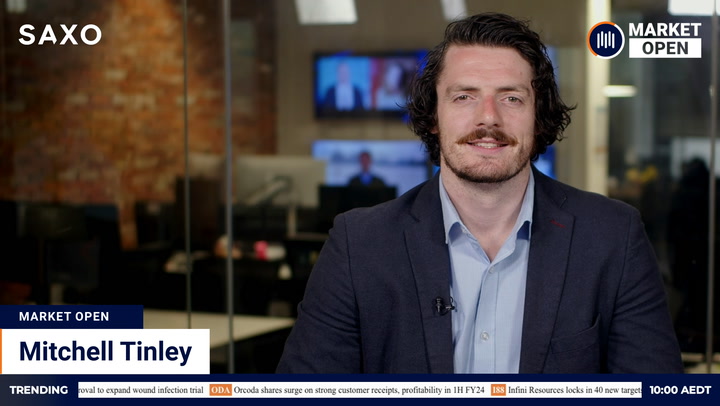Australian shares are pointing lower after the Federal Reserve raised US interest rates and forecast more hikes and a higher top for this rates cycle than some investors expected.
US stocks gave up early gains following the announcement. The major indices finished with losses of between 0.42 and 0.76 per cent.
The S&P/ASX 200 looks set to open 57 points or 0.79 per cent lower, according to futures moves. The Australian benchmark climbed 0.67 per cent yesterday to its highest close in a week.
Overnight, gold backed off its highest level in almost six months. Iron ore and oil rallied on hopes for Chinese stimulus measures as a wave of Covid cases threatens to disrupt the economy.
Wall Street
US stocks fell in volatile trade after the Fed lifted the target federal funds rate by half a percentage point, as expected, but disappointed the market with a hawkish outlook for next year. The central bank raised its peak rate projection and warned it needed to see inflation to cool significantly before changing its stance.
The S&P 500 swung to a loss of 24 points or 0.61 per cent. The Dow Jones Industrial Average gave up 142 points or 0.42 per cent. The Nasdaq Composite shed 86 points or 0.76 per cent.
This morning’s rate hike was the smallest in five meetings, following four straight raises of three-quarters of a percentage point. The increase lifted benchmark rates to 4.25-4.5 per cent.
What surprised the market was an increase in the bank’s forecast rate top or “terminal rate”. The bank projected the target federal funds rate will reach 5.1 per cent next year. Only two members of the Federal Open Market Committee saw benchmark rates staying below 5 per cent. Seven officials saw rates rising as high as 5.75 per cent.
“Two consecutive undershoots of inflation have led the market to believe we are getting very close to the peak for interest rates, and rate cuts will soon be on the agenda. The Fed clearly isn’t willing to make that call,” ING’s chief international economist James Knightley and colleagues Padhraic Garvey and Chris Turner wrote.
“The big issue that makes it hawkish is that the Fed’s forecasts put the terminal rate at 5.1% for 2023 from 4.6% at the September meeting,” Jim Caron of Morgan Stanley Investment Management told CNBC. “There’s no tip of the hat to the notion that inflation is starting to decline. They just completely ignored it.”
The statement accompanying the rate hike stuck largely to the same message as the previous meeting.
“Investors hoping for hints of an imminent Fed pivot embedded within the post-release statement were likely disappointed, which contained language virtually unchanged relative to the November meeting,” Jason Pride, chief investment officer of Private Wealth at Glenmede, said. “In particular, the recognition that ‘ongoing increases in the target range will be appropriate’ suggests that the Fed has no immediate plans to halt its rate hike campaign.”
In the post-meeting news conference, Fed Chair Jerome Powell said, “It will take substantially more evidence to have confidence that inflation is on a sustained downward path.” In his opinion, rates policy will have to remain “at a restrictive level for an extended period of time.”
Treasury yields briefly spiked before resetting lower. Similarly, the US dollar index jumped, then faded to a loss of around 0.3 per cent.
Australian outlook
A soft start is on the cards after the Fed confounded hopes for any near-term pivot towards a rates pause. The central bank delivered a smaller hike, as expected, but indicated the top of this cycle is still some way off.
The reaction on Wall Street was stormy, with various financial instruments plunging and rising and falling again. The dust was still settling as the session ended. Tonight’s action should provide a more measured market response.
In this volatile environment, havens outperformed. The health sector edged up 0.14 per cent. Utilities and consumer staples dropped less than 0.2 per cent.
Hardest hit by the night’s events were the two sectors with the biggest weighting on the ASX: financials -1.3 per cent and materials -1.12 per cent. Highly-geared REITs shed 1.02 per cent. Tech lost 0.86 per cent.
The S&P/ASX 200 rose yesterday for a second session after a drop in the pace of US inflation raised hopes of a more dovish Fed. The Australian benchmark climbed 0.67 per cent to its highest in a week. That gives the market something of a cushion this session.
The dollar resumed its push towards 69 US cents after a brief spike in the greenback faded. The Aussie was lately up 0.33 per cent to 68.64 US cents.
The next hurdle for investors is the November jobs report at 11.30 am AEDT. Economists expect another solid report, with gains of around 19,400 jobs keeping the jobless rate steady at 3.4 per cent. A surprise in either direction will affect how the Reserve Bank approaches its next rates decision in February.
China releases its monthly data dump at 1 pm, including factory output, retail sales, fixed asset investment and unemployment rate. There are interest rate decisions tonight in Euro-zone, the UK and Switzerland.
A big week of bank AGMs continues with a meeting for shareholders in ANZ. NAB follows tomorrow. Agribusiness Elders also holds its AGM today.
Commodities
Iron ore rallied on reports of fresh support ahead for China’s economy as a surge in Covid cases threatens to disrupt the economy. The government is likely to announce further measures to support growth, according to insiders and analysts interviewed by Reuters. The nation is battling a wave of infections after walking back its zero-Covid policy.
“The virus is rapidly spreading through households and offices and starting to put pressure on the hospital system. This could further weigh on consumer and industrial activity in the short term,” ANZ commodity strategists wrote.
The most-traded May ore on the Dalian Commodity Exchange rose 1.3 per cent in daytime trade to 808.50 yuan (US$116.19) a tonne.
BHP‘s US-traded depositary receipts sank 1.49 per cent following a loss of 2.3 per cent in UK trade. Rio Tinto shed 1.23 per cent in the US and 2.18 per cent in the UK.
Oil rose after the International Energy Agency upgraded its demand forecasts. The agency said growth will slow next year, but still be a healthy 1.7 per cent as China reopens after effectively abandoning zero-Covid.
“The stage is now set for a progressive reopening in 2023. We have raised our estimates for 2022 and next year’s growth by 50,000 bpd and 40,000 bpd, respectively,” the IEA said.
Brent crude settled US$2.02 or 2.5 per cent ahead at US$82.70 a barrel.
Gold retreated from its highest level in almost six months. Gold for February delivery settled US$6.80 or 0.4 per cent lower at US$1,818.70 an ounce. The NYSE Arca Gold Bugs Index lost 0.52 per cent.





